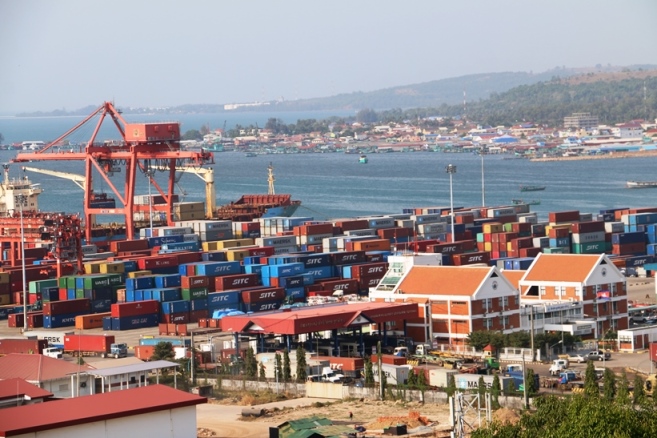 Despite a troubled recent history, Cambodia has been growing consistently in terms of economic growth over the last 10 years. Today, in 2016, Cambodia is now among the front-runners of the emerging economies of Southeast Asia. By focusing on a new industrial policy of Cambodia, this growth may continue and bring broader benefits to the country.
But how will the nation’s economy and industrial footprint diversify in skills and products to allow it to maintain this growth into the coming decade? And as importantly, how will Cambodia offer the lower economic sectors of society genuine opportunities to share the new wealth of the nation?
It is said in the Asian Development Outlook for 2016, of the Asian Development Bank (ADB), that Cambodia’s GDP had increased by approximately 7 percent since the year 2013; and has been projected to maintain that rate through 2017.
Along with data confirming the growth in the Kingdom’s GDP in its three-part discussion, the Asian Development Outlook 2016 also notes that “Cambodia’s large supply of inexpensive, low-skilled labor has attracted substantial foreign direct investment into the production of garments and footwear for export.”
One of the main factors that paved the way for all of this economic growth to happen is through the country’s adaptation of the “Factory Asia” model of economic growth; which allows the deployment of inexpensive labor into the industrial sector so that investors can manufacture products to be used for export.
Cambodia was able to obtain a competitive edge through this model and attracted regional manufacturing investors in droves. This was because the comparative price of labor gradually increased in other Asian countries, such as in China, while remained consistently low in Cambodia throughout the early 2000s.
The majority of the working class in the country who were once in poverty had found relative success through these manufacturing jobs. This allowed multiple opportunities for them to increase their family’s monthly income and provide for their children’s well-being, such as through education and proper nutrition. A far cry from the suffering average Cambodian had once been through.
Though it has been a long-fought struggle, Cambodia seems to be making progress in replicating the “Factory Asia” model and tailor-fitting it for their own culture and economy.
As evidence of this, the Kingdom got the largest overall contribution to GDP from the industrial segment growth in 2015; which was 11.7 percent last year. This growth was largely because of a 14.1 percent increase in exporting merchandise; which came in during 2015 at roughly $8.5 billion. An increase of 10.2 percent was also observed in the shipment of footwear such as shoes and sandals, and garments which makes up 70 percent of Cambodia’s total exports.
Although factories have helped in providing financial stability and sustainability, this sector has not represented a monopoly on Cambodia’s growth as the country entered the twentieth century.
Another contributor to Cambodia’s GDP is the services industry. This industry showed a significant amount of growth; as it ballooned with a 7.1 percent increase last year. The communications sector, along with the transport and finance sectors, grew by around 8 percent. The tourism sector also saw an increase in tourist arrivals that made a 6.1 percent difference to GDP growth in the year 2015. Cambodia’s once predominant and primary sector, agriculture, is also predicted to observe growth by an increase of 1.6 percent next year.
But the Asian Development Outlook 2016 warns that “while the economy shows signs of becoming more diversified within and across sectors, including garments and light manufacturing, and in export destinations, the base for growth remains narrow.”
So, while Cambodia has shown much progress over the years, the nation is still in need of diversity in its economy as it becomes even more competitive with countries like Myanmar and Vietnam, frontrunners in manufacturing low-cost garments.
To support this diversification process, the government offers a new industrial policy of Cambodia that aims to upgrade its industries from providing labor intensive, low-cost manufacturing to a more value-centered production system; so as to encourage the expansion of medium and small-sized entities or corporations by way of an industrial development policy that will enforce stronger regulations, better business dealings and modernization.
With an inexpensive, young and fast-learning population, tech industries also seem to offer vast opportunities in the Kingdom. These industries also offer a superior quality of life, and potential for career development, than base-line industrial jobs.
With this agenda taken into consideration, ADB says that the industry segment is projected to grow in the following year by around 9.5 per cent.
While Cambodia has seen some triumphs in recent years, it still has many more battles to win. The world is watching while the next tiger of ASEAN grows up.
Despite a troubled recent history, Cambodia has been growing consistently in terms of economic growth over the last 10 years. Today, in 2016, Cambodia is now among the front-runners of the emerging economies of Southeast Asia. By focusing on a new industrial policy of Cambodia, this growth may continue and bring broader benefits to the country.
But how will the nation’s economy and industrial footprint diversify in skills and products to allow it to maintain this growth into the coming decade? And as importantly, how will Cambodia offer the lower economic sectors of society genuine opportunities to share the new wealth of the nation?
It is said in the Asian Development Outlook for 2016, of the Asian Development Bank (ADB), that Cambodia’s GDP had increased by approximately 7 percent since the year 2013; and has been projected to maintain that rate through 2017.
Along with data confirming the growth in the Kingdom’s GDP in its three-part discussion, the Asian Development Outlook 2016 also notes that “Cambodia’s large supply of inexpensive, low-skilled labor has attracted substantial foreign direct investment into the production of garments and footwear for export.”
One of the main factors that paved the way for all of this economic growth to happen is through the country’s adaptation of the “Factory Asia” model of economic growth; which allows the deployment of inexpensive labor into the industrial sector so that investors can manufacture products to be used for export.
Cambodia was able to obtain a competitive edge through this model and attracted regional manufacturing investors in droves. This was because the comparative price of labor gradually increased in other Asian countries, such as in China, while remained consistently low in Cambodia throughout the early 2000s.
The majority of the working class in the country who were once in poverty had found relative success through these manufacturing jobs. This allowed multiple opportunities for them to increase their family’s monthly income and provide for their children’s well-being, such as through education and proper nutrition. A far cry from the suffering average Cambodian had once been through.
Though it has been a long-fought struggle, Cambodia seems to be making progress in replicating the “Factory Asia” model and tailor-fitting it for their own culture and economy.
As evidence of this, the Kingdom got the largest overall contribution to GDP from the industrial segment growth in 2015; which was 11.7 percent last year. This growth was largely because of a 14.1 percent increase in exporting merchandise; which came in during 2015 at roughly $8.5 billion. An increase of 10.2 percent was also observed in the shipment of footwear such as shoes and sandals, and garments which makes up 70 percent of Cambodia’s total exports.
Although factories have helped in providing financial stability and sustainability, this sector has not represented a monopoly on Cambodia’s growth as the country entered the twentieth century.
Another contributor to Cambodia’s GDP is the services industry. This industry showed a significant amount of growth; as it ballooned with a 7.1 percent increase last year. The communications sector, along with the transport and finance sectors, grew by around 8 percent. The tourism sector also saw an increase in tourist arrivals that made a 6.1 percent difference to GDP growth in the year 2015. Cambodia’s once predominant and primary sector, agriculture, is also predicted to observe growth by an increase of 1.6 percent next year.
But the Asian Development Outlook 2016 warns that “while the economy shows signs of becoming more diversified within and across sectors, including garments and light manufacturing, and in export destinations, the base for growth remains narrow.”
So, while Cambodia has shown much progress over the years, the nation is still in need of diversity in its economy as it becomes even more competitive with countries like Myanmar and Vietnam, frontrunners in manufacturing low-cost garments.
To support this diversification process, the government offers a new industrial policy of Cambodia that aims to upgrade its industries from providing labor intensive, low-cost manufacturing to a more value-centered production system; so as to encourage the expansion of medium and small-sized entities or corporations by way of an industrial development policy that will enforce stronger regulations, better business dealings and modernization.
With an inexpensive, young and fast-learning population, tech industries also seem to offer vast opportunities in the Kingdom. These industries also offer a superior quality of life, and potential for career development, than base-line industrial jobs.
With this agenda taken into consideration, ADB says that the industry segment is projected to grow in the following year by around 9.5 per cent.
While Cambodia has seen some triumphs in recent years, it still has many more battles to win. The world is watching while the next tiger of ASEAN grows up.

Updated on: June 6, 2022, 5:04 p.m.
Published on: May 12, 2016, 10:50 a.m.
New Industrial Policy of Cambodia: The next step toward continued growth
 Despite a troubled recent history, Cambodia has been growing consistently in terms of economic growth over the last 10 years. Today, in 2016, Cambodia is now among the front-runners of the emerging economies of Southeast Asia. By focusing on a new industrial policy of Cambodia, this growth may continue and bring broader benefits to the country.
But how will the nation’s economy and industrial footprint diversify in skills and products to allow it to maintain this growth into the coming decade? And as importantly, how will Cambodia offer the lower economic sectors of society genuine opportunities to share the new wealth of the nation?
It is said in the Asian Development Outlook for 2016, of the Asian Development Bank (ADB), that Cambodia’s GDP had increased by approximately 7 percent since the year 2013; and has been projected to maintain that rate through 2017.
Along with data confirming the growth in the Kingdom’s GDP in its three-part discussion, the Asian Development Outlook 2016 also notes that “Cambodia’s large supply of inexpensive, low-skilled labor has attracted substantial foreign direct investment into the production of garments and footwear for export.”
One of the main factors that paved the way for all of this economic growth to happen is through the country’s adaptation of the “Factory Asia” model of economic growth; which allows the deployment of inexpensive labor into the industrial sector so that investors can manufacture products to be used for export.
Cambodia was able to obtain a competitive edge through this model and attracted regional manufacturing investors in droves. This was because the comparative price of labor gradually increased in other Asian countries, such as in China, while remained consistently low in Cambodia throughout the early 2000s.
The majority of the working class in the country who were once in poverty had found relative success through these manufacturing jobs. This allowed multiple opportunities for them to increase their family’s monthly income and provide for their children’s well-being, such as through education and proper nutrition. A far cry from the suffering average Cambodian had once been through.
Though it has been a long-fought struggle, Cambodia seems to be making progress in replicating the “Factory Asia” model and tailor-fitting it for their own culture and economy.
As evidence of this, the Kingdom got the largest overall contribution to GDP from the industrial segment growth in 2015; which was 11.7 percent last year. This growth was largely because of a 14.1 percent increase in exporting merchandise; which came in during 2015 at roughly $8.5 billion. An increase of 10.2 percent was also observed in the shipment of footwear such as shoes and sandals, and garments which makes up 70 percent of Cambodia’s total exports.
Although factories have helped in providing financial stability and sustainability, this sector has not represented a monopoly on Cambodia’s growth as the country entered the twentieth century.
Another contributor to Cambodia’s GDP is the services industry. This industry showed a significant amount of growth; as it ballooned with a 7.1 percent increase last year. The communications sector, along with the transport and finance sectors, grew by around 8 percent. The tourism sector also saw an increase in tourist arrivals that made a 6.1 percent difference to GDP growth in the year 2015. Cambodia’s once predominant and primary sector, agriculture, is also predicted to observe growth by an increase of 1.6 percent next year.
But the Asian Development Outlook 2016 warns that “while the economy shows signs of becoming more diversified within and across sectors, including garments and light manufacturing, and in export destinations, the base for growth remains narrow.”
So, while Cambodia has shown much progress over the years, the nation is still in need of diversity in its economy as it becomes even more competitive with countries like Myanmar and Vietnam, frontrunners in manufacturing low-cost garments.
To support this diversification process, the government offers a new industrial policy of Cambodia that aims to upgrade its industries from providing labor intensive, low-cost manufacturing to a more value-centered production system; so as to encourage the expansion of medium and small-sized entities or corporations by way of an industrial development policy that will enforce stronger regulations, better business dealings and modernization.
With an inexpensive, young and fast-learning population, tech industries also seem to offer vast opportunities in the Kingdom. These industries also offer a superior quality of life, and potential for career development, than base-line industrial jobs.
With this agenda taken into consideration, ADB says that the industry segment is projected to grow in the following year by around 9.5 per cent.
While Cambodia has seen some triumphs in recent years, it still has many more battles to win. The world is watching while the next tiger of ASEAN grows up.
Despite a troubled recent history, Cambodia has been growing consistently in terms of economic growth over the last 10 years. Today, in 2016, Cambodia is now among the front-runners of the emerging economies of Southeast Asia. By focusing on a new industrial policy of Cambodia, this growth may continue and bring broader benefits to the country.
But how will the nation’s economy and industrial footprint diversify in skills and products to allow it to maintain this growth into the coming decade? And as importantly, how will Cambodia offer the lower economic sectors of society genuine opportunities to share the new wealth of the nation?
It is said in the Asian Development Outlook for 2016, of the Asian Development Bank (ADB), that Cambodia’s GDP had increased by approximately 7 percent since the year 2013; and has been projected to maintain that rate through 2017.
Along with data confirming the growth in the Kingdom’s GDP in its three-part discussion, the Asian Development Outlook 2016 also notes that “Cambodia’s large supply of inexpensive, low-skilled labor has attracted substantial foreign direct investment into the production of garments and footwear for export.”
One of the main factors that paved the way for all of this economic growth to happen is through the country’s adaptation of the “Factory Asia” model of economic growth; which allows the deployment of inexpensive labor into the industrial sector so that investors can manufacture products to be used for export.
Cambodia was able to obtain a competitive edge through this model and attracted regional manufacturing investors in droves. This was because the comparative price of labor gradually increased in other Asian countries, such as in China, while remained consistently low in Cambodia throughout the early 2000s.
The majority of the working class in the country who were once in poverty had found relative success through these manufacturing jobs. This allowed multiple opportunities for them to increase their family’s monthly income and provide for their children’s well-being, such as through education and proper nutrition. A far cry from the suffering average Cambodian had once been through.
Though it has been a long-fought struggle, Cambodia seems to be making progress in replicating the “Factory Asia” model and tailor-fitting it for their own culture and economy.
As evidence of this, the Kingdom got the largest overall contribution to GDP from the industrial segment growth in 2015; which was 11.7 percent last year. This growth was largely because of a 14.1 percent increase in exporting merchandise; which came in during 2015 at roughly $8.5 billion. An increase of 10.2 percent was also observed in the shipment of footwear such as shoes and sandals, and garments which makes up 70 percent of Cambodia’s total exports.
Although factories have helped in providing financial stability and sustainability, this sector has not represented a monopoly on Cambodia’s growth as the country entered the twentieth century.
Another contributor to Cambodia’s GDP is the services industry. This industry showed a significant amount of growth; as it ballooned with a 7.1 percent increase last year. The communications sector, along with the transport and finance sectors, grew by around 8 percent. The tourism sector also saw an increase in tourist arrivals that made a 6.1 percent difference to GDP growth in the year 2015. Cambodia’s once predominant and primary sector, agriculture, is also predicted to observe growth by an increase of 1.6 percent next year.
But the Asian Development Outlook 2016 warns that “while the economy shows signs of becoming more diversified within and across sectors, including garments and light manufacturing, and in export destinations, the base for growth remains narrow.”
So, while Cambodia has shown much progress over the years, the nation is still in need of diversity in its economy as it becomes even more competitive with countries like Myanmar and Vietnam, frontrunners in manufacturing low-cost garments.
To support this diversification process, the government offers a new industrial policy of Cambodia that aims to upgrade its industries from providing labor intensive, low-cost manufacturing to a more value-centered production system; so as to encourage the expansion of medium and small-sized entities or corporations by way of an industrial development policy that will enforce stronger regulations, better business dealings and modernization.
With an inexpensive, young and fast-learning population, tech industries also seem to offer vast opportunities in the Kingdom. These industries also offer a superior quality of life, and potential for career development, than base-line industrial jobs.
With this agenda taken into consideration, ADB says that the industry segment is projected to grow in the following year by around 9.5 per cent.
While Cambodia has seen some triumphs in recent years, it still has many more battles to win. The world is watching while the next tiger of ASEAN grows up.



Comments